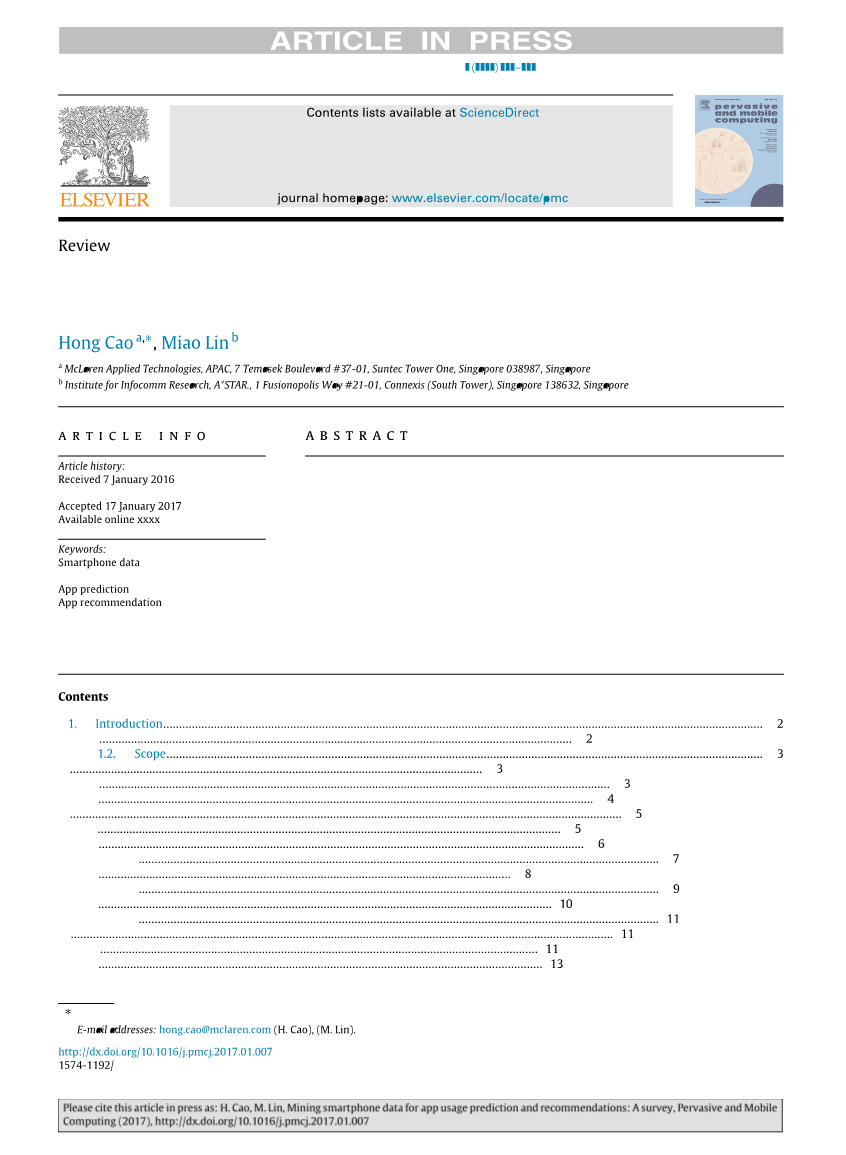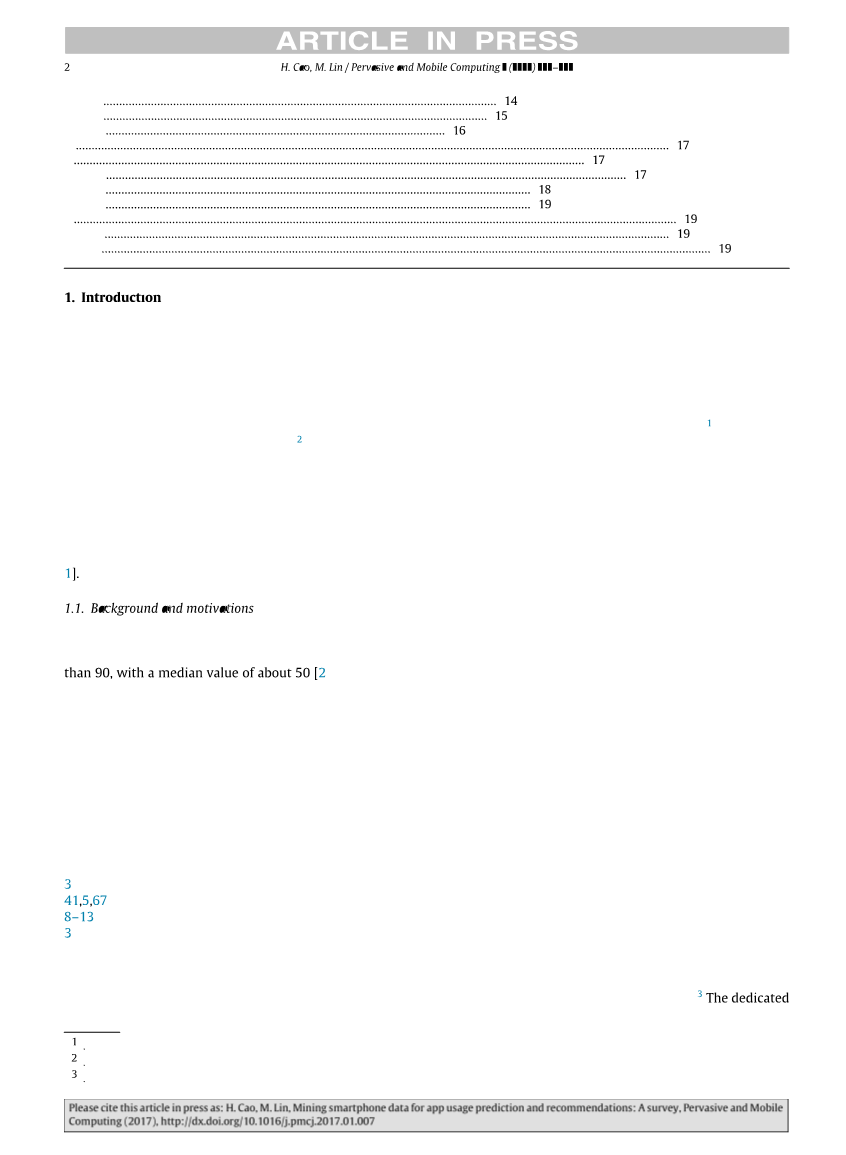酒店客房预订平台的设计与实现外文翻译资料
2022-07-25 13:22:53


英语原文共 22 页,剩余内容已隐藏,支付完成后下载完整资料
摘要Abstract
Smartphones nowadays have become indispensable personal gadgets to support our activities in almost every aspect of our lives.
如今智能手机已经成为支持我们日常活动,在我们生活中的各个方面都不可或缺的个人工具。
Thanks to the tremendous advancement of smartphone technologies, platforms, as well as the enthusiasm of individual developers, numerous mobile applications (apps) have been created to serve a wide range of usage purposes, making our daily life more convenient.
由于智能手机技术、平台的巨大的进步以及个体开发人员积极性,创建了许多提供广泛的使用目的的移动应用程序,使我们的日常生活更方便。
While these apps are used, data logs are typically generated and ambience context is recorded forming a rich data source of the smartphone usersrsquo; behaviors.
当人们使用这些应用程序时,通常会生成数据日志,并记录环境氛围,形成智能手机用户丰富行为的数据源。
In this paper, we survey existing studies on mining smartphone data for uncovering app usage patterns leveraging such a data source.
在本文中,我们将利用这样的数据源,调查现有的挖掘智能手机数据、揭示APP的使用模式的研究。
Our discussions of the studies are organized according to two main research streams, namely app usage prediction and app recommendations alongside a few other related studies. Finally,we also present several challenges and opportunities in the emerging area of mining smartphone usage patterns.
我们的研究讨论的依据主要来自于两个主要的研究流派,即APP使用预测和应用建议,以及一些其他相关的研究。最后,在新兴领域的智能手机使用模式的挖掘上,我们也提出了一些挑战和机遇。
模型建立【APP使用预测】
App usage prediction refers to the task of predicting the next app that will be used for a given user an data given time.In this section,we review and discuss several essential aspects of current app usage prediction literature,including two types of features used,various predictive modeling methodologies,as well as some practical implementation issues.
APP使用预测是指,给定一个特定用户一定时间的使用数据,从而预测下一个使用的APP的任务。在这一部分中,我们会回顾和讨论当前应用程序的使用预测文献的几个重要方面,包括两种类型的使用功能,各种预测建模方法,以及一些实际的实施问题。
1.1两种常见的特征类型
In smartphone data mining, the features used are typically categorized into explicit and implicit types. Similarly, we formalize the explicit features as readily available information extracted from the phone. Implicit features instead refer to the subtle derived app statistics.
在智能手机数据挖掘领域,使用的功能通常分为显式和隐式类型。同样,我们将从手机中提取的现成的信息转化成了正式明确的功能。隐含的功能,不是指简单的派生应用程序统计。
The explicit features include: (1) location and environmental data of various types, (2) time information, e.g. hour of the day, day of the week, and (3) smartphone modes extracted from the phonersquo;s settings, e.g. airplane mode, vibrate mode, silent mode. Specifically, we categorize the explicit features into four types below:
而是指明确的功能,其中包括:(1)各种类型的位置和环境数据,(2)时间信息,如一天中的一天,一周的时间,和(3)从手机的设置中提取的智能手机模式,如飞机模式,振动模式,静音模式。具体来说,我们分类明确的功能分为以下四种类型:
bull; Location features refer to both the location and other data sources that can imply locations, including: GPS, WiFi access points (APs) and cell tower IDs. Other forms of data can also be translated into locations. For instance, Huang et al. translated the signals from WiFi APs into locations. Also, a number of studies furnished the locations with semantics through integrating the crowdsourced location labels.
bull;位置特征指的是能暗示地点的位置和其他数据源,包括:GPS,WiFi接入点(APs)和手机信号发射塔ID。其他形式的数据也可以被翻译成位置。例如,黄等。将从WiFi接入点的信号翻译转换成位置。另外,相当一部分的研究提示,与语义结合位置的众包研究也能提示位置。
bull; Time-based features refer to hour of the day and day of the week in majority of the cases. The works in suggested that features for smartphone data can be computed separately for different temporal contexts. We often call these features temporal features.
bull;基于时间的功能是指在大多数情况下的一天的一小四和一周中的一天。在一些研究工作中表明,智能手机的功能可以为数据分别计算不同时空背景。我们通常称这些特征为时间特征。
Table 2
Feature and performance comparison of next-app prediction studies, where top-K denotes the evaluation is based on top-K selected candidate apps, MRR stands for mean reciprocal rank, MAP for mean average precision, MAR for mean average recall, NDCG for normalized discounted cumulative gain and Acc for the accuracy and lsquo;lsquo;–rsquo;rsquo; and lsquo;lsquo;?rsquo;rsquo; for unreported information.
表2是特点和性能比较下应用的预测研究,其中在一指的评估是基于Top-k候选应用,MRR代表平均倒数排名,MAP指的是平均精度,MAR指的是平均应答数,NDCG为归一化的贴现累计收益,ACC指的是准确性,“–”和“?”指的是未报告的信息。
bull; Phone settings features refer to the settings of smartphones. Such information can be the phone mode, the ring volume and other settings that a phone user can set. As suggested in, phone settings features can be used to effectively filter out unlikely app candidates in the given circumstances.
bull;手机设置功能则是参考智能手机的设置。这样的信息可以是一个电话用户可是设置的电话模式,铃声音量或者其他设置等等。正如大家所知道的的那样,在给定的情况下,手机设置功能可以用来有效地筛选出不可能的应用程序候选。
bull; Phone status features refer to the status of the smartphones. Such features can be battery level, screen brightness, phone movement and phone carrying position identified based on accelerometer and proximity sensor readings.
bull;电话状态功能则是参照智能手机的状态。这些功能状态可以是电池电量,屏幕亮度,手机移动距离和基于加速度传感器或者接近传感器读数从而确定电话携带的位置。
As mentioned above, implicit features are derived app usage statistics, which require feature engineering and data modeling, and are subtle in nature. They can be correlation statistics of app usage sequences, distribution of the app usage duration and probability of each app being the first to be used. It was reported by that the implicit features tended to be more effective in distinguishing app usage behaviors as compared with the explicit features. Table 2 overviews and compares the explicit and implicit features for the next-app prediction literature. In the next section, we will discuss how implicit features are modeled in the current works.
如上所述,隐含的功能是派生的应用程序使用的统计数据,这需要功能工程和数据建模,并在本质上是十分精细的。它们可以是相关的应用程序的使用顺序,应用程序使用时间的分布和每个应用程序的概率是第一个使用的相关性统计。据报道,相比于明确的功能,隐式功能往往是更有效的区分应用程序的使用行为。表2概述并比较了显性和隐性特征的下一个应用预测文献。在下一节中,我们将讨论如何在当前工程中建模隐式特征。
1.2隐式特征建模
Given the dependency of consecutive apps and their immediate previous apps in the app usage sequence, it is often assumed that Markovian property stands. The works in therefore proposed to
全文共32366字,剩余内容已隐藏,支付完成后下载完整资料
资料编号:[145044],资料为PDF文档或Word文档,PDF文档可免费转换为Word




